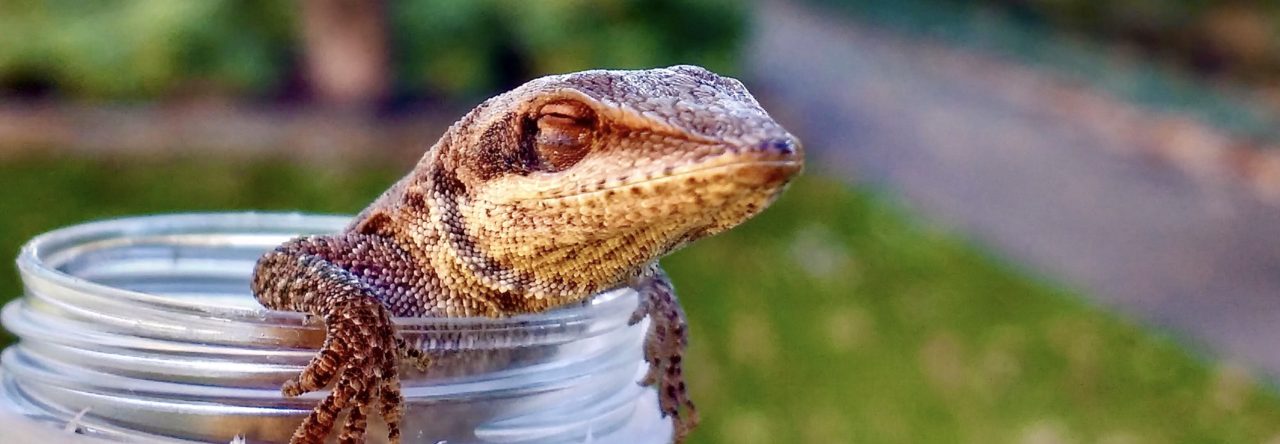The green anole, A. carolinensis, is the only native anole in North America. Over the years, the question of whether it is distinct from the Cuban A. porcatus has been debated–morphological differences are pretty minor, other than the Cubans generally being a bit larger.
Now, in an open access paper published last year in Ecology and Evolution, Johanna Wegener and colleagues have driven the final nail in the coffin of the idea that North American carolinensis is a distinct species.
For some time, we have known that carolinensis is nested phylogenetically in the western clade of porcatus, rending porcatus paraphyletic. This phylogeny indicates that North American populations are the result of a colonization event from western Cuba, perhaps 6-12 million years ago (see references in Wegener et al. paper).

From Wegener et al. (2019). Florida populations are usually referred to as “ carolinensis,” Cuban populations as “porcatus“
The novel contribution of the Wegener et al. paper is to look for evidence of hybridization between recently introduced “porcatus” from Cuba and native “carolinensis.” And she found it in spades! The abstract, pasted at the bottom of this post, provides some more details and, of course, you can read the paper itself.
So, Florida populations of the green anole are derived from Cuban populations, and the two readily interbreed when given a chance. Given these facts, there is no justification for treating North American populations as a distinct species. The morphological differences that do exist–quite minor–are the result of geographic variation. Paraphyly plus no reproductive isolation = one species!
But now here’s where it gets interesting. By the rules of zoological nomenclature, the older name has precedence, and so this single species takes the name Anolis carolinensis. That’s right: A. carolinensis is the correct name for Cuban green anoles! I’m sure that won’t go over so well in some quarters.
 But it gets more interesting! Cuban Anolis porcatus as currently recognized is not a monophyletic entity, as shown in the attached figure, based on Glor et al. (2005). As the figure shows, eastern populations of porcatus are more closely related to A. allisoni (remember, North American populations are nested in the western clade). Given that the species-level distinctness of allisoni has not been question, most systematists would recognize the two clades of porcatus as different species. Thus, the eastern clade retains the name porcatus.
But it gets more interesting! Cuban Anolis porcatus as currently recognized is not a monophyletic entity, as shown in the attached figure, based on Glor et al. (2005). As the figure shows, eastern populations of porcatus are more closely related to A. allisoni (remember, North American populations are nested in the western clade). Given that the species-level distinctness of allisoni has not been question, most systematists would recognize the two clades of porcatus as different species. Thus, the eastern clade retains the name porcatus.
Bottom line: both A. carolinensis and A. porcatus occur in Cuba!
Abstract
In allopatric species, reproductive isolation evolves through the accumulation of genetic incompatibilities. The degree of divergence required for complete reproductive isolation is highly variable across taxa, which makes the outcome of secondary contact between allopatric species unpredictable. Since before the Pliocene, two species of Anolis lizards, Anolis carolinensis and Anolis porcatus, have been allopatric, yet thisvperiod of independent evolution has not led to substantial species‐specific morphologicalvdifferentiation, and therefore, they might not be reproductively isolated. Invthis study, we determined the genetic consequences of localized, secondary contactvbetween the native green anole, A. carolinensis, and the introduced Cuban green anole, A. porcatus, in South Miami. Using 18 microsatellite markers, we found that the South Miami population formed a genetic cluster distinct from both parental species. Mitochondrial DNA revealed maternal A. porcatus ancestry for 35% of the individuals sampled from this population, indicating a high degree of cytonuclear discordance. Thus, hybridization with A. porcatus, not just population structure within A. carolinensis, may be responsible for the genetic distinctiveness of this population. Using treebased maximum‐likelihood analysis, we found support for a more recent, secondary introduction of A. porcatus to Florida. Evidence that ~33% of the nuclear DNA resulted from a secondary introduction supports the hybrid origin of the green anole population in South Miami. We used multiple lines of evidence and multiple genetic markers to reconstruct otherwise cryptic patterns of species introduction and hybridization. Genetic evidence for a lack of reproductive isolation, as well as morphological similarities between the two species, supports revising the taxonomy of A. carolinensis to include A. porcatus from western Cuba. Future studies should target the current geographic extent of introgression originating from the past injection of genetic material from Cuban green anoles and determine the consequences for the evolutionary trajectory of green anole populations in southern Florida.





















